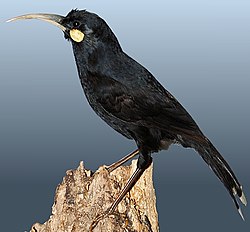Huia: Difference between revisions
GrahamBould (talk | contribs) mNo edit summary |
GrahamBould (talk | contribs) mNo edit summary |
||
| Line 22: | Line 22: | ||
==Appearance== |
==Appearance== |
||
The bird had blue-black plumage, bright orange |
The bird had blue-black [[plumage]], bright orange [[wattle]]s at the [[gape]] and white-tipped tail feathers. It was the only bird known in which the bills of the male and female were radically different. The male's beak was short (approximately 60 mm) and straight while the female's beak was long and curved (up to 100 mm), a striking example of [[sexual dimorphism]]. Huia had been little studied by Western naturalists before they were driven to extinction. |
||
==Diet== |
==Diet== |
||
| Line 28: | Line 28: | ||
==Reproduction== |
==Reproduction== |
||
The breeding season was thought to be early summer, with the birds constructing a saucer-shaped nest about |
The breeding season was thought to be early summer, with the birds constructing a saucer-shaped nest about 35 cm across. Two to four greyish eggs of 30-40 mm were normally laid. |
||
==Habitat== |
==Habitat== |
||
Revision as of 14:08, 19 May 2006
- This article is about the Huia, an extinct bird species. For the place, see Huia (place). For the frog genus, see Huia (genus).
| Huia | |
|---|---|

| |
| Female (back) and Male (front) Huia | |
| Scientific classification | |
| Kingdom: | |
| Phylum: | |
| Class: | |
| Order: | |
| Family: | |
| Genus: | Heteralocha Cabanis, 1851
|
| Species: | H. acutirostris
|
| Binomial name | |
| Heteralocha acutirostris (Gould, 1837)
| |
The Huia (Heteralocha acutirostris) was a bird endemic to New Zealand. It is now extinct, with no reliable sightings since W.W. Smith saw three birds in the Tararua Ranges on 28 December 1907.
Appearance
The bird had blue-black plumage, bright orange wattles at the gape and white-tipped tail feathers. It was the only bird known in which the bills of the male and female were radically different. The male's beak was short (approximately 60 mm) and straight while the female's beak was long and curved (up to 100 mm), a striking example of sexual dimorphism. Huia had been little studied by Western naturalists before they were driven to extinction.
Diet
Sexual dimorphism of the bill structure was an adaptation to the co-operative feeding strategies of the bird. The male used his bill to chisel into outer layers of decaying or live wood, thereby allowing the female to probe into areas inaccessible to the male. Anatomy of the male bird's head and neck musculature also suggests the male could insert his bill into rotting wood and force his bill open to split the wood. Diet consisted of insects and their larvae, spiders, and small berries. The meals were shared.
Reproduction
The breeding season was thought to be early summer, with the birds constructing a saucer-shaped nest about 35 cm across. Two to four greyish eggs of 30-40 mm were normally laid.
Habitat
Subfossil bones of Huia have been found in several North Island sites; however, live birds were only recorded by European settlers in southern areas of the island, normally the Tararua and Rimutaka Ranges. The bird shares its name with a small community in the Waitakere Ranges, where it may have once been found. Huia moved mainly on foot, flying weakly, and would call with a shrill whistle to ensure other members of the cohort were close by. An imitation of the bird's call survives as a recording of a 1907 Huia Search Team member, Henare Haumana whistling the call (NZ Sound Archives).
Decline

Several naturalists, including Buller, noted that the birds were already in decline when European settlers arrived. The Huia's distinctive white-tipped black tail feathers were often worn by Maori chiefs as a sign of their status. Such feathers were revered as taonga (treasures) by Maori. The wearing of feathers as ornaments was later adopted by Pakeha women as a symbol of social standing. The birds were inqusitive and trapped easily upon imitation of their call — in 1888, a party of 11 Maori obtained 646 Huia skins from the forest between the Manawatu Gorge and Akitio. In February 1892, regulations making it illegal to kill or take Huia were passed; however, enforcement was not taken seriously. The visit of the Duke of York, later King George V, to New Zealand in 1902 produced a frenzied demand for Huia feathers, especially after the Duke wore a Huia tail feather in his hatband. The price of feathers was reportedly pushed to one pound a piece. The then Governor General, the Earl of Onslow, tried to provide further legal protection for the Huia, but the bird was reported extinct shortly afterwards.
References
- Gill, B. and Martinson, P. (1991) New Zealand's Extinct Birds Random Century, Auckland
- Buller, W.L. (1888) Buller's Birds of New Zealand
